Abstract
alpha-Methylphenylalanine is a very weak competitive inhibitor of rat liver phenylalanine hydroxylase in vitro but a potent suppressor in vivo. The loss of the hepatic activity (the renal one is unaffected) becomes maximal (70-75% decrease; cf. control) 18h after the administration (per 10g body wt.) of 24 mumol of alpha-methylphenylalanine with or without 52 mumol of phenylalanine. Chronic suppression of hepatic phenylalanine hydroxylase was obtained by injections of alpha-methylphenylalanine plus phenylalanine to suckling rats, and by their addition to the diet after weaning. A series of comparisons of the effects of this treatment, and one with p-chlorophenylalanine, was then carried out. In both cases there was a rise (1.3-2-fold) in phenylalanine-pyruvate amino-transferase activity (but no change in four other enzyme activities) in the liver; in brain there was a rise in phosphoserine phosphatase activity, but the total activity and subcellular distribution of nine enzymes revealed no other abnormalities in cerebral development. Striking increases in the concentration of plasma phenylalanine during 26 of the 31 experimental days (with a transient fall at 18-22 days) were maintained by treatment with both analogues plus phenylalanine. However, p-chlorophenylalanine-treated animals had a 30-60% mortality rate and 27-52% decrease in body weight. Developing rats treated with alpha-methylphenylalanine, showing no growth deficit or signs of toxicity (e.g. cataracts), appear to be a more suitable model for the human disease of phenylketonuria. Their phenylalanine concentrations exhibited at least 20-40-fold increase during 50% of each of the first 18 days of life, and 30-fold after weaning.
Full text
PDF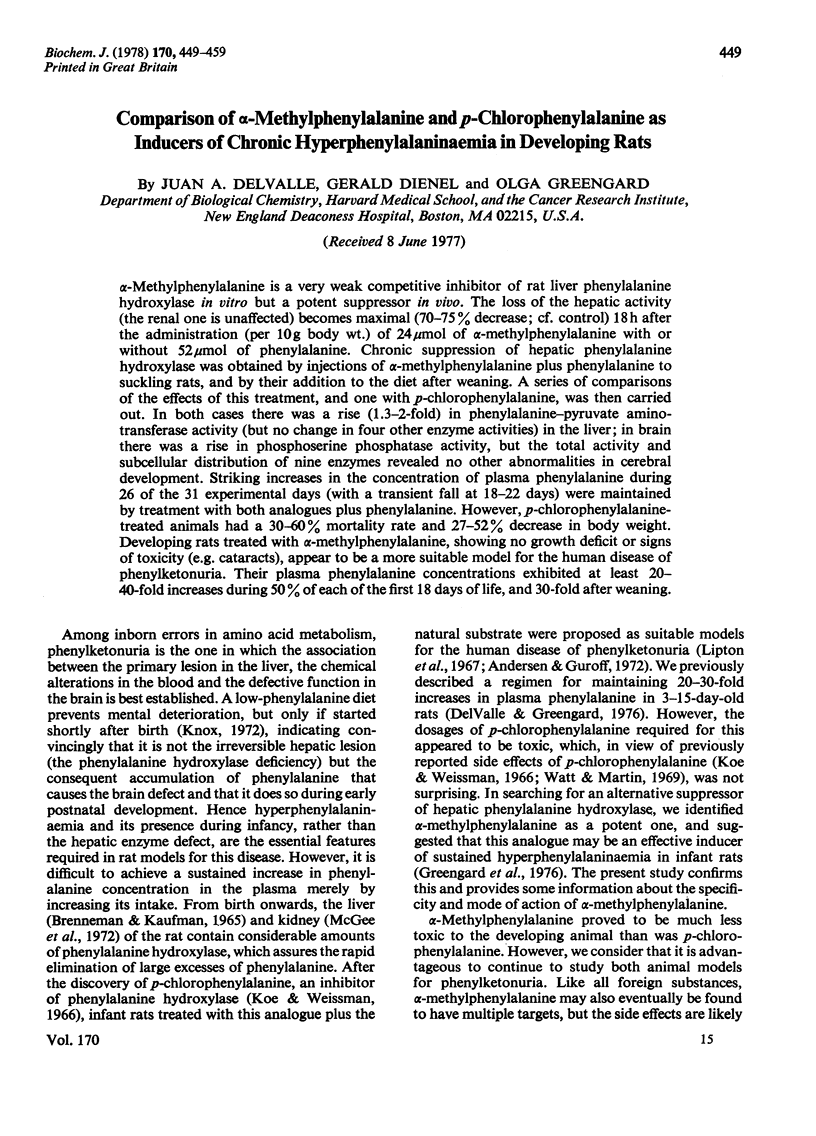
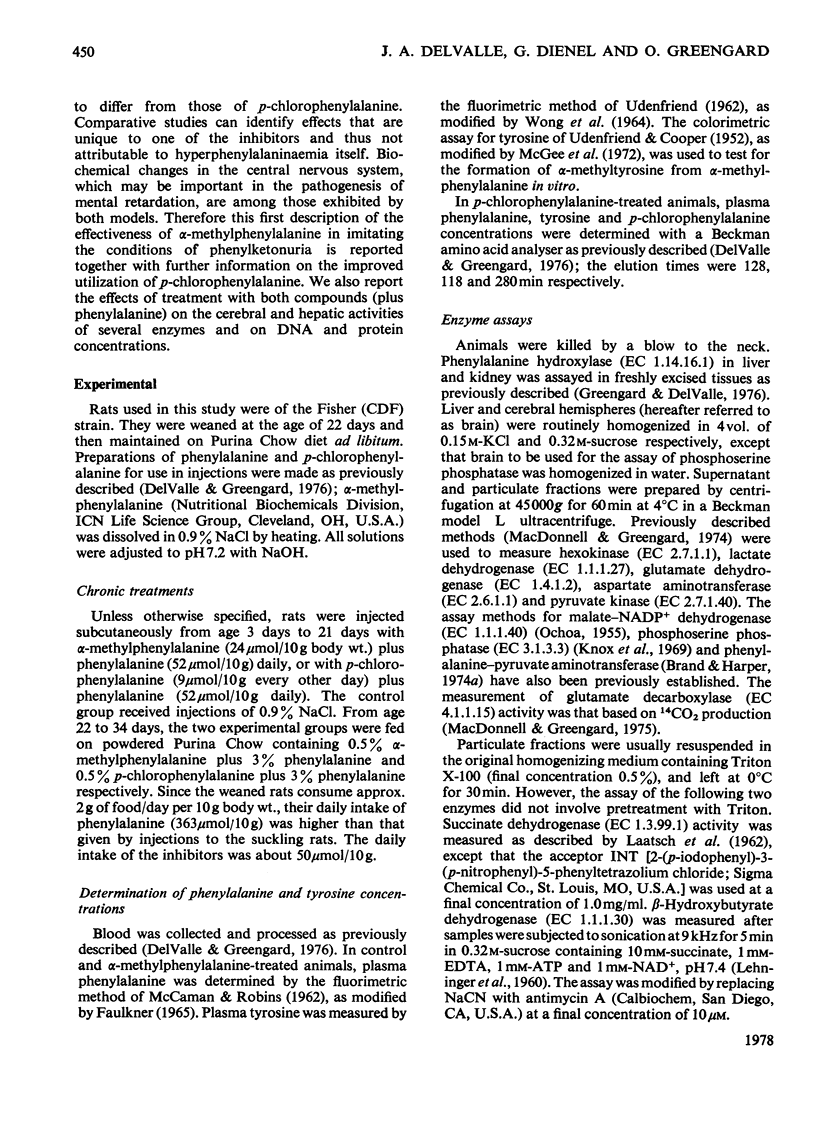
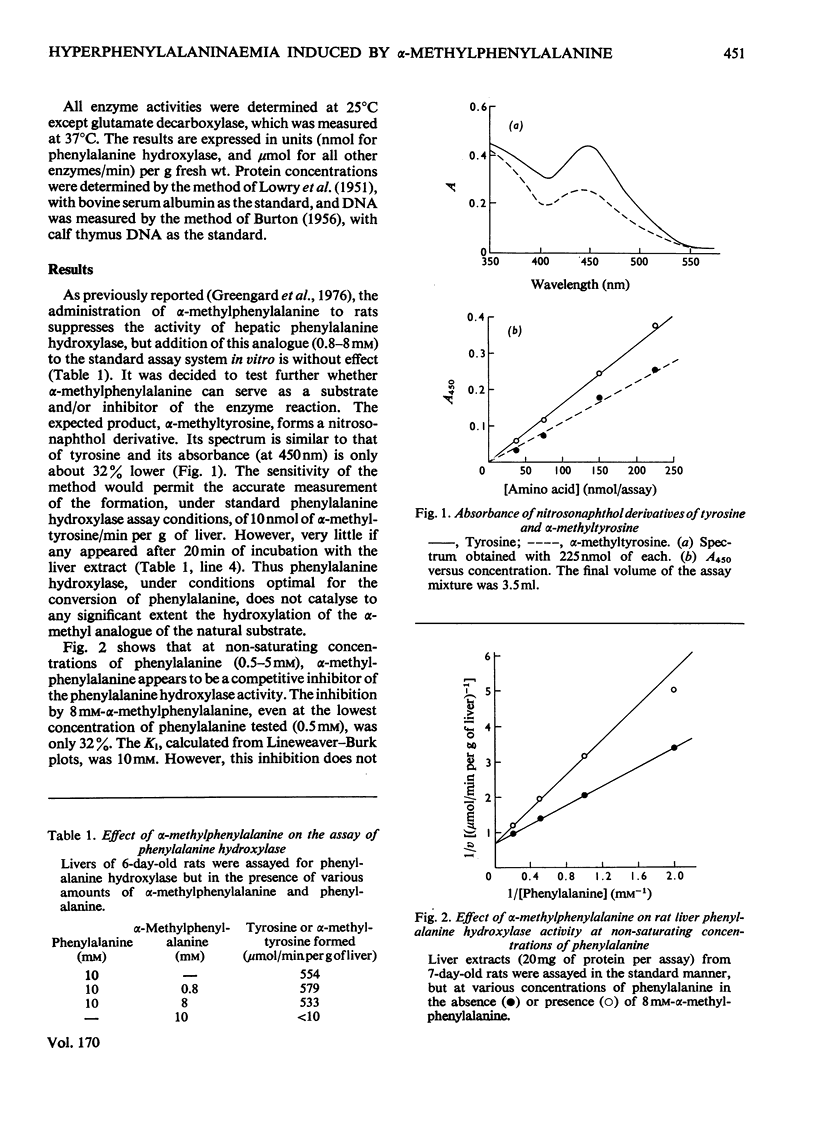
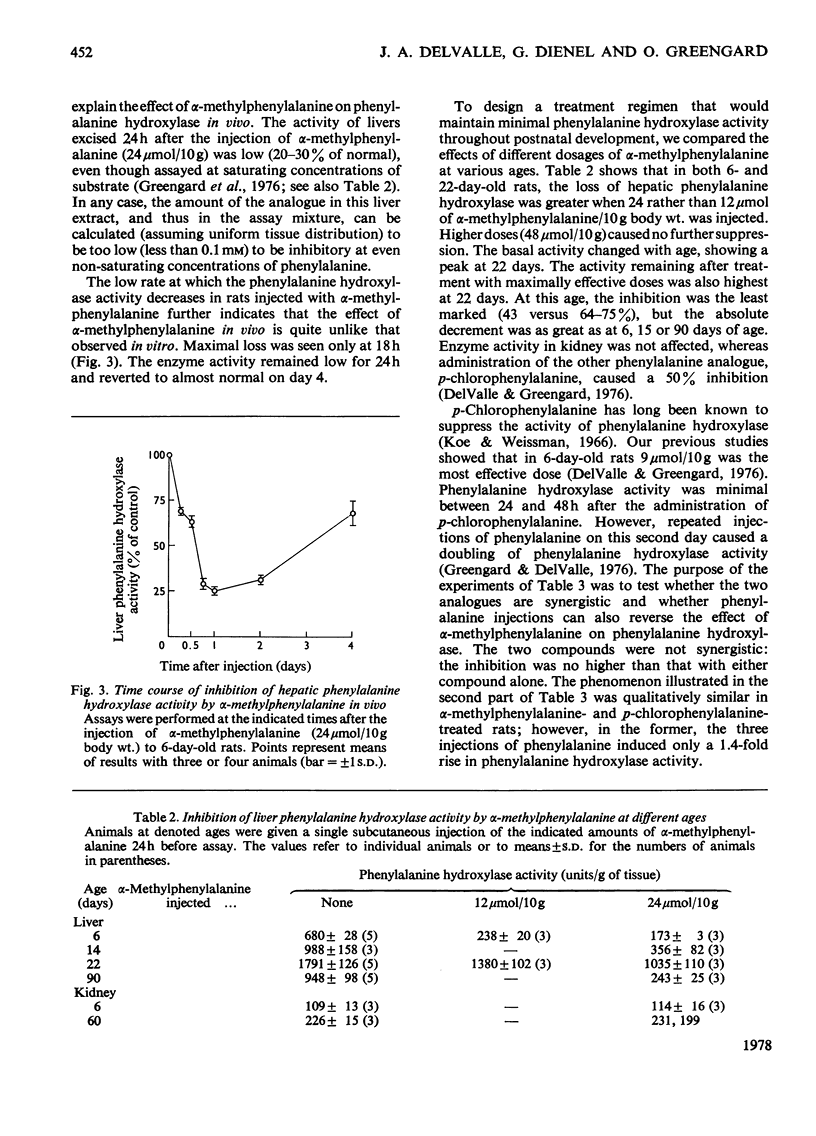
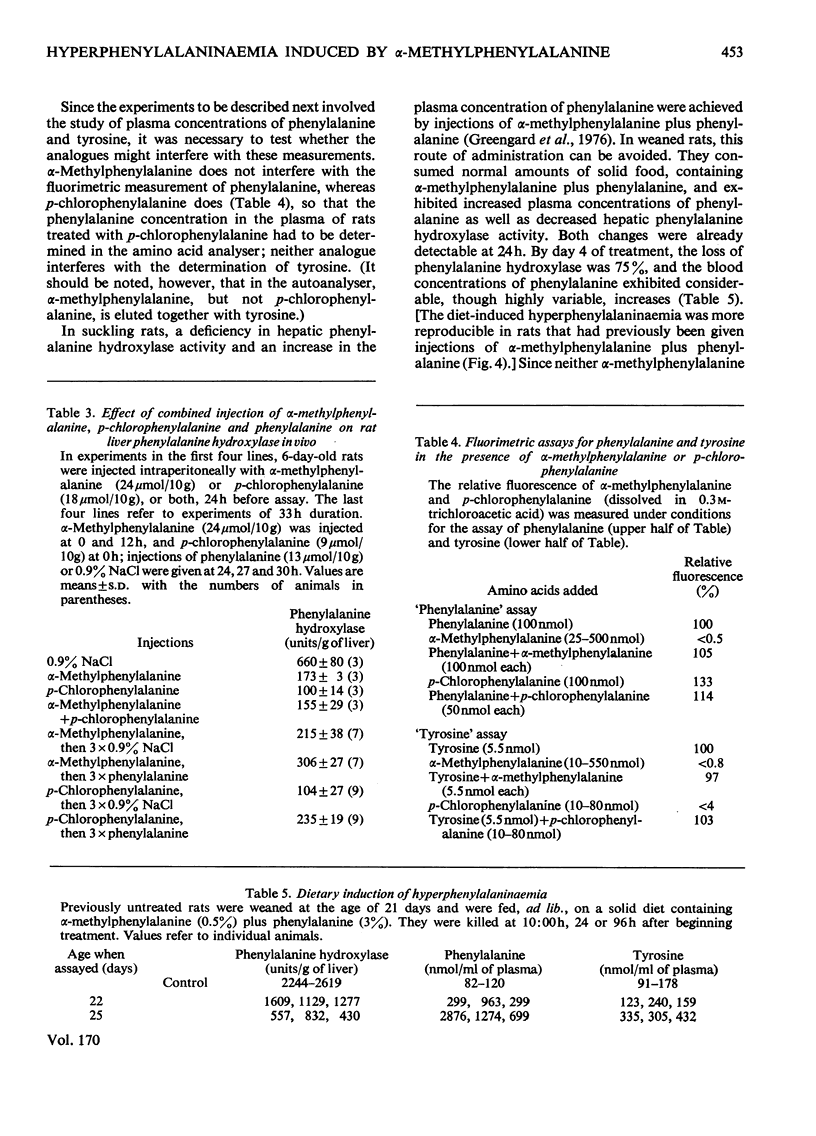
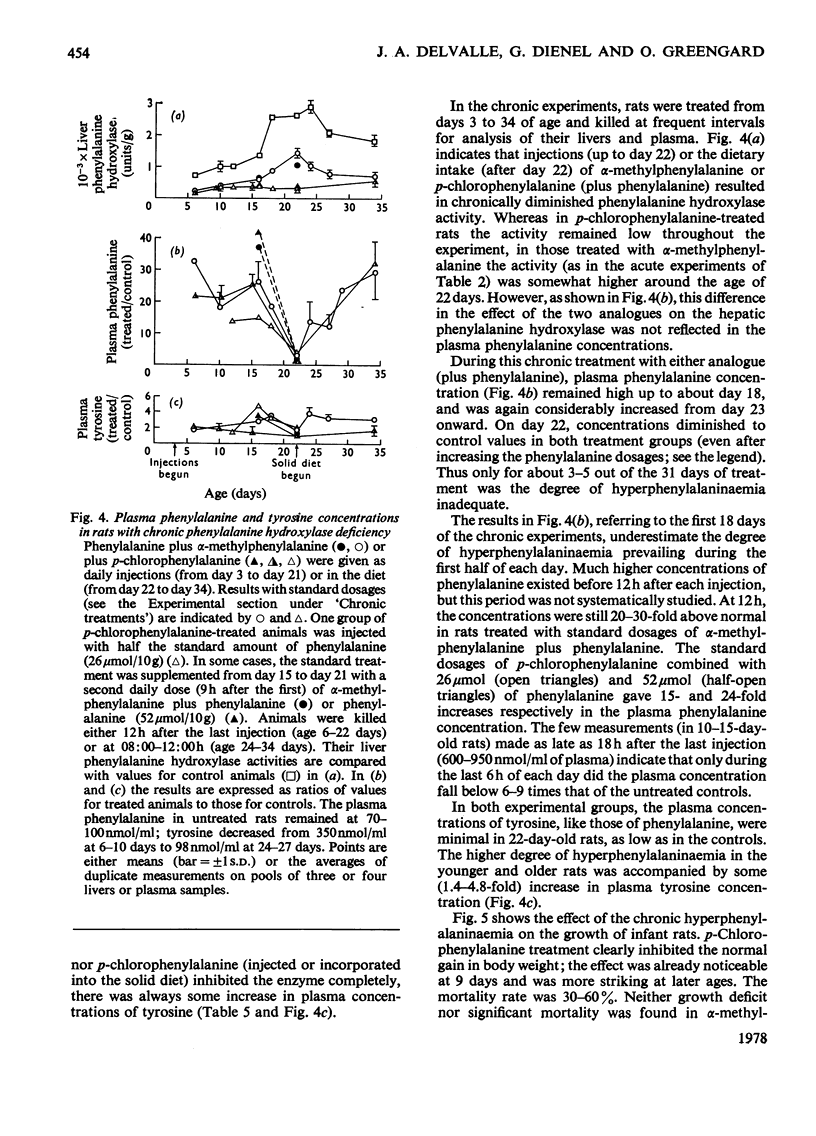
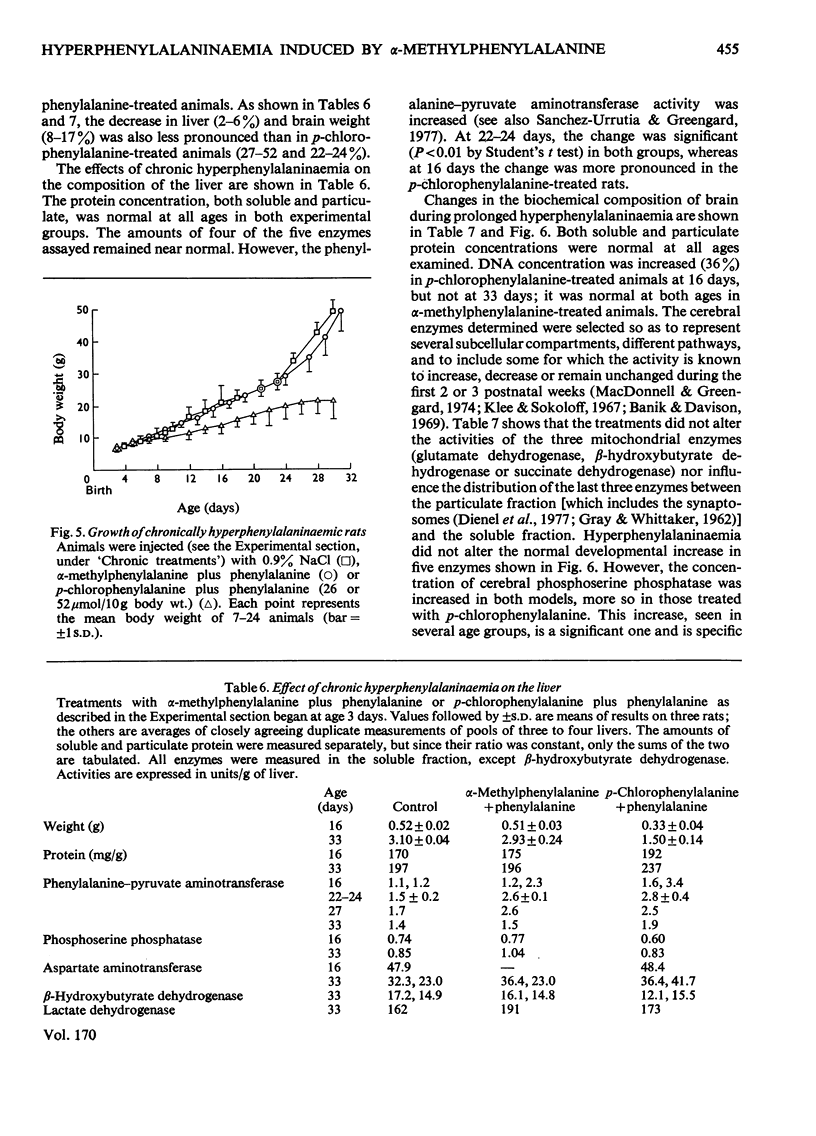
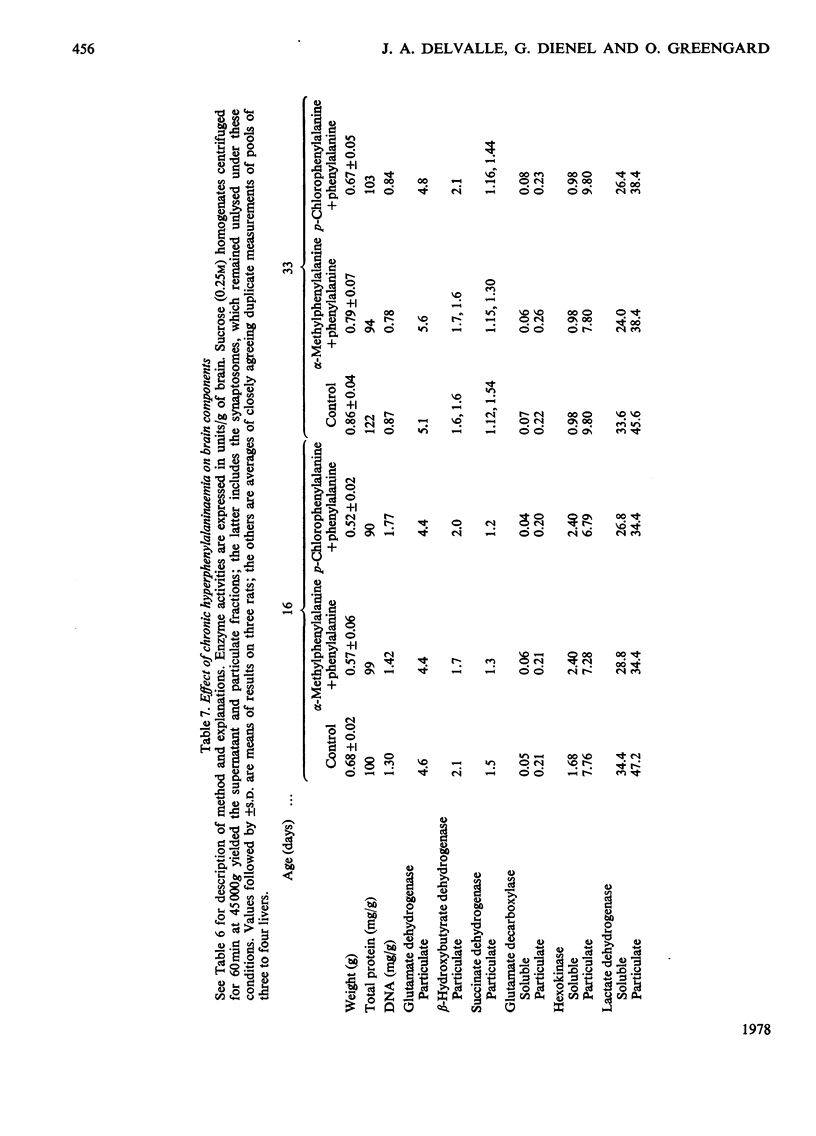
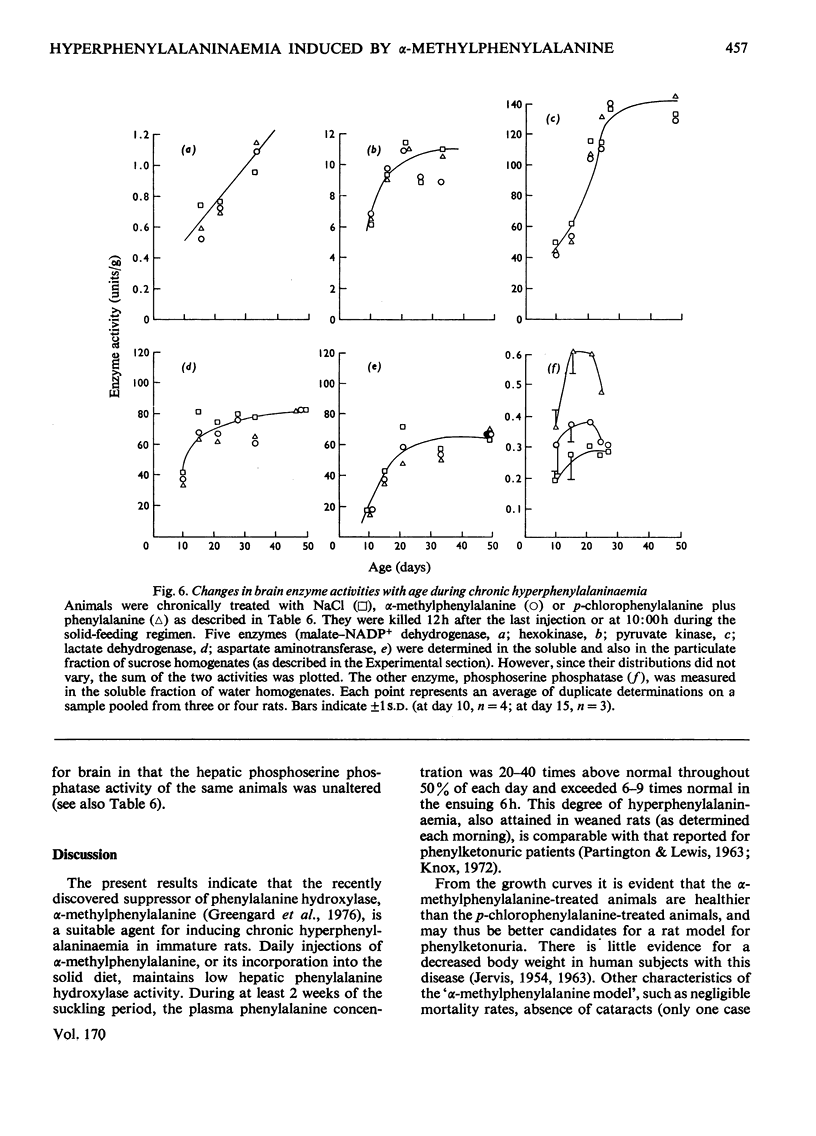
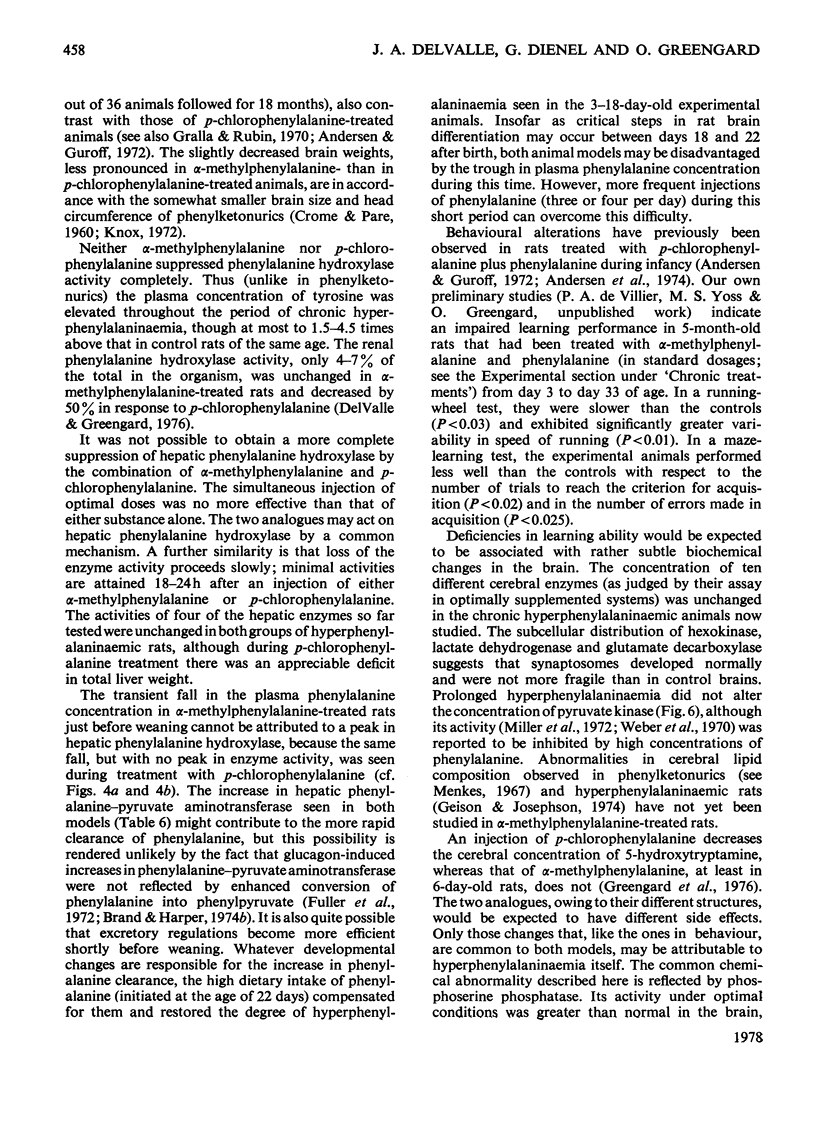
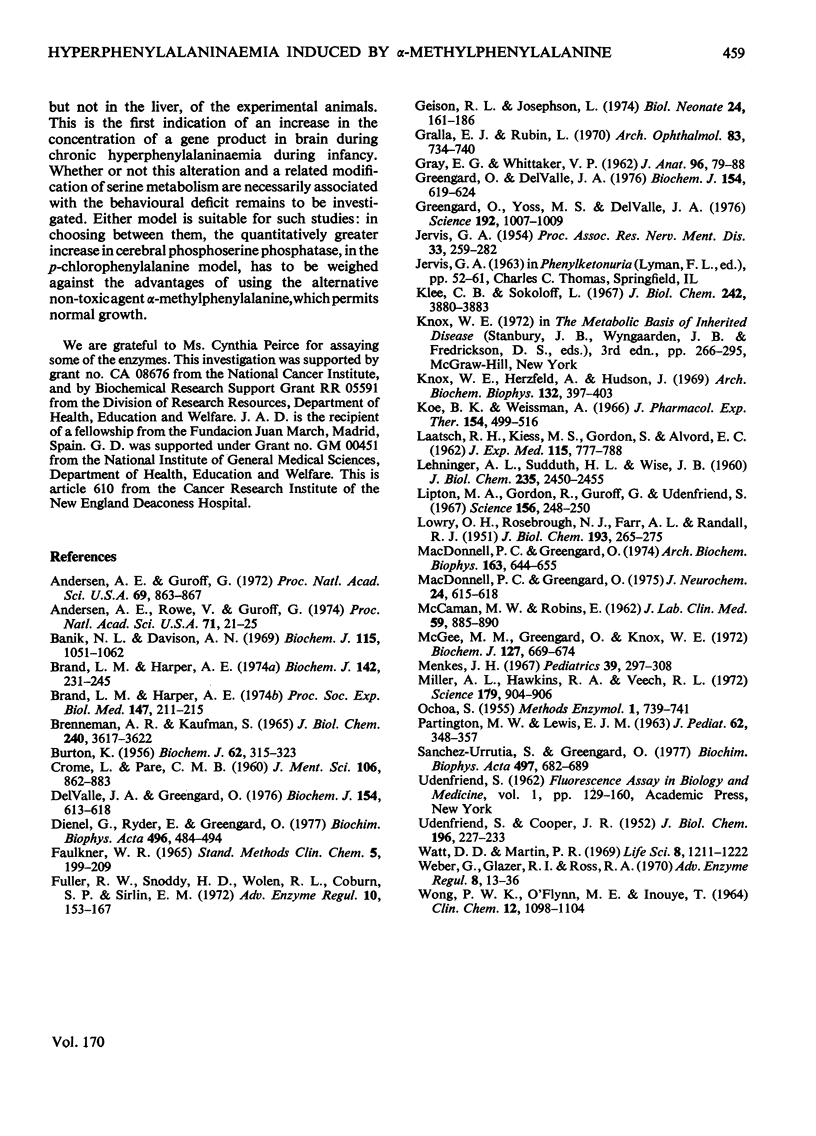
Selected References
These references are in PubMed. This may not be the complete list of references from this article.
- Andersen A. E., Guroff G. Enduring behavioral changes in rats with experimental phenylketonuria. Proc Natl Acad Sci U S A. 1972 Apr;69(4):863–867. doi: 10.1073/pnas.69.4.863. [DOI] [PMC free article] [PubMed] [Google Scholar]
- Andersen A. E., Rowe V., Guroff G. The enduring behavioral changes in rats with experimental phenylketonuria. Proc Natl Acad Sci U S A. 1974 Jan;71(1):21–25. doi: 10.1073/pnas.71.1.21. [DOI] [PMC free article] [PubMed] [Google Scholar]
- BURTON K. A study of the conditions and mechanism of the diphenylamine reaction for the colorimetric estimation of deoxyribonucleic acid. Biochem J. 1956 Feb;62(2):315–323. doi: 10.1042/bj0620315. [DOI] [PMC free article] [PubMed] [Google Scholar]
- Banik N. L., Davison A. N. Enzyme activity and composition of myelin and subcellular fractions in the developing rat brain. Biochem J. 1969 Dec;115(5):1051–1062. doi: 10.1042/bj1151051. [DOI] [PMC free article] [PubMed] [Google Scholar]
- Brand L. M., Harper A. E. Effect of glucagon on phenylalanine metabolism and phenylalanine-degrading enzymes in the rat. Biochem J. 1974 Aug;142(2):231–245. doi: 10.1042/bj1420231. [DOI] [PMC free article] [PubMed] [Google Scholar]
- Brand L. M., Harper A. E. Studies on the functional significance of rat liver phenylalanine:pyruvate aminotransferase. Proc Soc Exp Biol Med. 1974 Oct;147(1):211–215. doi: 10.3181/00379727-147-38313. [DOI] [PubMed] [Google Scholar]
- Brenneman A. R., Kaufman S. Characteristics of the hepatic phenylalanine-hydroxylating system in newborn rats. J Biol Chem. 1965 Sep;240(9):3617–3622. [PubMed] [Google Scholar]
- Delvalle J. A., Greengard O. The regulation of phenylalanine hydroxylase in rat tissues in vivo. The maintenance of high plasma phenylalanine concentrations in suckling rats: a model for phenylketonuria. Biochem J. 1976 Mar 15;154(3):613–618. doi: 10.1042/bj1540613. [DOI] [PMC free article] [PubMed] [Google Scholar]
- Dienel G., Ryder E., Greengard O. Distribution of mitochondrial enzymes between the perikaryal and synaptic fractions of immature and adult rat brain. Biochim Biophys Acta. 1977 Feb 28;496(2):484–494. doi: 10.1016/0304-4165(77)90330-0. [DOI] [PubMed] [Google Scholar]
- Fuller R. W., Snoddy H. D., Wolen R. L., Coburn S. P., Sirlin E. M. Effect of glucagon and p-chlorophenylalanine on hepatic enzymes that metabolize phenylalanine. Adv Enzyme Regul. 1972;10:153–167. doi: 10.1016/0065-2571(72)90012-x. [DOI] [PubMed] [Google Scholar]
- GRAY E. G., WHITTAKER V. P. The isolation of nerve endings from brain: an electron-microscopic study of cell fragments derived by homogenization and centrifugation. J Anat. 1962 Jan;96:79–88. [PMC free article] [PubMed] [Google Scholar]
- Geison R. L., Josephson L. Lipid metabolism in liver and brain in acute hyperphenylalaninemia in rats of different ages. Correlation with tissue phenylalanine and tyrosine levels. Biol Neonate. 1974;24(3):161–186. doi: 10.1159/000240649. [DOI] [PubMed] [Google Scholar]
- Gralla E. J., Rubin L. Ocular studies with para-chlorophenylalanine in rats and monkeys. Arch Ophthalmol. 1970 Jun;83(6):734–740. doi: 10.1001/archopht.1970.00990030734012. [DOI] [PubMed] [Google Scholar]
- Greengard O., Delvalle J. A. The regulation of phenylalanine hydroxylase in rat tissues in vivo. Substrate- and cortisol-induced elevations in phenylalanine hydroxylase activity. Biochem J. 1976 Mar 15;154(3):619–624. doi: 10.1042/bj1540619. [DOI] [PMC free article] [PubMed] [Google Scholar]
- Greengard O., Yoss M. S., Del Valle J. A. Alpha-methylphenylalanine, a new inducer of chronic hyperphenylalaninemia in sucling rats. Science. 1976 Jun 4;192(4243):1007–1008. doi: 10.1126/science.944951. [DOI] [PubMed] [Google Scholar]
- JERVIS G. A. Phenylpyruvic oligophrenia (phenylketonuria). Res Publ Assoc Res Nerv Ment Dis. 1954;33:259–282. [PubMed] [Google Scholar]
- Klee C. B., Sokoloff L. Changes in D(--)-beta-hydroxybutyric dehydrogenase activity during brain maturation in the rat. J Biol Chem. 1967 Sep 10;242(17):3880–3883. [PubMed] [Google Scholar]
- Knox W. E., Herzfeld A., Hudson J. Phosphoserine phosphatase distribution in normal and neoplastic rat tissues. Arch Biochem Biophys. 1969 Jul;132(2):397–403. doi: 10.1016/0003-9861(69)90381-6. [DOI] [PubMed] [Google Scholar]
- Koe B. K., Weissman A. p-Chlorophenylalanine: a specific depletor of brain serotonin. J Pharmacol Exp Ther. 1966 Dec;154(3):499–516. [PubMed] [Google Scholar]
- LEHNINGER A. L., SUDDUTH H. C., WISE J. B. D-beta-Hydroxybutyric dehydrogenase of muitochondria. J Biol Chem. 1960 Aug;235:2450–2455. [PubMed] [Google Scholar]
- LOWRY O. H., ROSEBROUGH N. J., FARR A. L., RANDALL R. J. Protein measurement with the Folin phenol reagent. J Biol Chem. 1951 Nov;193(1):265–275. [PubMed] [Google Scholar]
- Lipton M. A., Gordon R., Guroff G., Udenfriend S. p-Chlorophenylalanine-induced chemical manifestations of phenylketonuria in rats. Science. 1967 Apr 14;156(3772):248–250. doi: 10.1126/science.156.3772.248. [DOI] [PubMed] [Google Scholar]
- MacDonnell P. C., Greengard O. Enzymes in intracellular organelles of adult and developing rat brain. Arch Biochem Biophys. 1974 Aug;163(2):644–655. doi: 10.1016/0003-9861(74)90525-6. [DOI] [PubMed] [Google Scholar]
- MacDonnell P., Greengard O. The distribution of glutamate decarboxylase in rat tissues; isotopic vs fluorimetric assays. J Neurochem. 1975 Apr;24(4):615–618. [PubMed] [Google Scholar]
- McGee M. M., Greengard O., Knox W. E. The quantitative determination of phenylalanine hydroxylase in rat tissues. Its developmental formation in liver. Biochem J. 1972 May;127(4):669–674. doi: 10.1042/bj1270669. [DOI] [PMC free article] [PubMed] [Google Scholar]
- Menkes J. H. The pathogenesis of mental retardation in phenylketonuria and other inborn errors of amino acid metabolism. Pediatrics. 1967 Feb;39(2):297–308. [PubMed] [Google Scholar]
- Miller A. L., Hawkins R. A., Veech R. L. Phenylketonuria: phenylalanine inhibits brain pyruvate kinase in vivo. Science. 1973 Mar 2;179(4076):904–906. doi: 10.1126/science.179.4076.904. [DOI] [PubMed] [Google Scholar]
- PARTINGTON M. W., LEWIS E. J. Variations with age in plasma phenylalanine and tyrosine levels in phenylketonuria. J Pediatr. 1963 Mar;62:348–357. doi: 10.1016/s0022-3476(63)80131-6. [DOI] [PubMed] [Google Scholar]
- Sanchez-Urretia L., Greengard O. Phenylalanine-pyruvate aminotransferase in immature and adult mammalian tissues. Induction in fetal rat liver. Biochim Biophys Acta. 1977 May 26;497(3):682–689. doi: 10.1016/0304-4165(77)90289-6. [DOI] [PubMed] [Google Scholar]
- UDENFRIEND S., COOPER J. R. The chemical estimation of tyrosine and tyramine. J Biol Chem. 1952 May;196(1):227–233. [PubMed] [Google Scholar]
- WONG P. W., O'FLYNN M. E., INOUYE T. MICROMETHODS FOR MEASURING PHENYLALANINE AND TYROSINE IN SERUM. Clin Chem. 1964 Dec;10:1098–1104. [PubMed] [Google Scholar]
- Watt D. D., Martin P. R. Phenylalanine antimetabolite effect on development. I. Behavioral effects of D,L-4-chlorophenylalanine in the young rat. Life Sci. 1969 Nov 1;8(21):1211–1222. doi: 10.1016/0024-3205(69)90050-2. [DOI] [PubMed] [Google Scholar]
- Weber G., Glazer R. I., Ross R. A. Regulation of human and rat brain metabolism: inhibitory action of phenylalanine and phenylpyruvate on glycolysis, protein, lipid, DNA, and RNA metabolism. Adv Enzyme Regul. 1970;8:13–36. doi: 10.1016/0065-2571(70)90006-3. [DOI] [PubMed] [Google Scholar]


